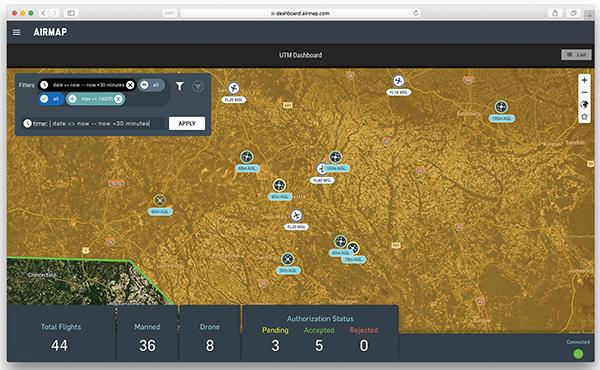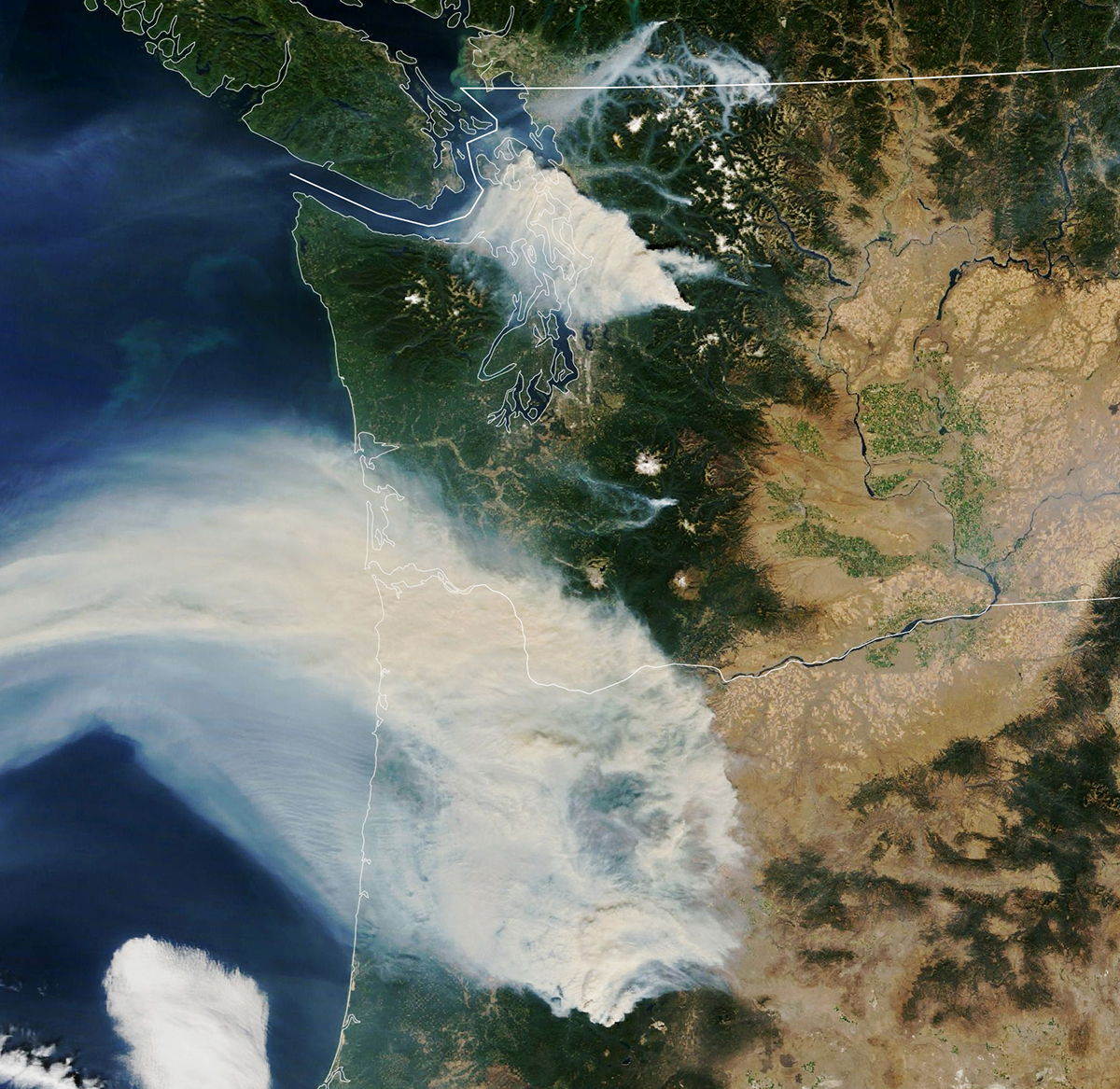
Where the Wildfires Are
Subheadline
Simulation, prediction, and response software helps businesses and communities cope with disaster
“This is a fire planet as much as it’s a water planet, so we need to be able to use fire as our friend and thrive,” said Jessica McCarty, branch chief of Biospheric Sciences at NASA's Ames Research Center in Silicon Valley, California. Part of the space agency’s job is to help monitor and understand our home planet, including natural disasters. In the case of wildfires, this means developing technology and gathering data to help wildland fire management agencies predict and put out fires.
As the agency tries to “solve the impossible problem of catastrophic wildfires” by providing resources to improve mitigation and community response, McCarty said the combination of data and technology is helping firefighters. Businesses are also benefiting, with help from Technosylva Inc., a company that combines fire science and NASA data to create fire simulation and forecast software.
Globally, as much as 90% of all wildfires start with a human ignition source, said McCarty. This is just one example of the sort of knowledge that helps predict and prevent wildfires, a challenge that NASA and industry are undertaking together.
Joaquin Ramirez, president of San Diego-based Technosylva, said the company has been working to understand wildfires since 1997 by combining science, data, and technology. It begins with the numerous elements that influence a fire. From the natural world, that includes the interaction of terrain, vegetation, soil moisture, weather, climate, and more. Human influences include alterations to the natural landscape such as housing developments, wetland elimination, dams, and power generation and distribution.
Technosylva developed software that combines these factors with data from NASA and other sources to model fires, predict their spread, and potential impacts, and provide up-to-date information for crews fighting wildfires. “We need technologies that bridge the gap between scientists and the user community, because that community has to address those problems every day, everywhere, all at once,” said Ramirez.
The company, which started in Spain, now has more than 90 staff members in 11 countries, collaborating with research institutions to access the most current scientific findings and provide operational tools.
Not Waiting on Heroes
The view from space provides a different perspective on natural disasters like wildfires and the conditions that affect them. Sensors on Earth-observation satellites and the International Space Station not only capture that view but can turn it into quantifiable data, measuring soil moisture, vegetation health, and other factors. NASA turns this information into datasets for anyone to use.
“For vegetation condition or what is sometimes referred to as ‘fuels,’ this information helps to assess and predict risk for human and animal communities, vulnerable populations, infrastructure, and economies,” said McCarty. This might mean a power company that wants to prevent fires evaluating above-ground powerlines standing in migrations corridors. A bird flying into power lines can cause sparks that ignite grass and leaves below, so removing that fuel could be helpful.
San Diego Gas & Electric, a Technosylva customer, created a wildfire climate adaptation department to better understand and mitigate the effect climate change is having on current infrastructure and future operations. Utilities in other states are learning how to deal with wildfires in areas that never experienced them, and others are facing increased fire intensity. Pacific Gas& Electric, Southern California Edison in California, Pacific Power in Oregon, Xcel Energy in Colorado, and Rocky Mountain Power in Utah are all using Technosylva products to make these adjustments.
Government agencies in the Netherlands, Northern Ireland, and Italy haven’t had to deal with wildfires as intense as those in the western U.S. But the risk and frequency of wildland fires is increasing in those places too. Technosylva is working with them on mitigation and planning to enhance public-safety planning.
“In many places we hear ‘thank you’ for firefighters as heroes. But they don’t need to be heroes – they are usually underpaid and die at the end of the movie,” said Ramirez. “We need to build more resilient landscapes, that will create safer communities.” That happens, he said, by educating the public and businesses about their environment. Technosylva helps community leaders do that by using simulations to identify high-risk areas and how to reduce that risk.
A Backward View
Technosylva’s Wildfire Analyst software employs artificial intelligence and machine learning to combine multiple data sources and run half a billion of wildfire-spread simulations every day. The software can evaluate wildfire risk in real time, whether for an active fire or in forecasts that use short-term conditions to find at-risk areas. Historical data, including conditions for previous fires, “teaches” the program what conditions will lead to increased wildfire risk.
FireSim, one of Wildfire Analyst’s core applications, uses this data to simulate wildfire behavior. Some of the data comes from the NASA-built Landsat satellites that have supplied the longest record of Earth’s surface. NASA’s Moderate Resolution Imaging Spectroradiometer (MODIS) and Visible Infrared Imaging Radiometer Suite (VIIRS) instruments provide weather information and the health status of vegetation. The agency’s Global Ecosystem Dynamics Investigation (GEDI) high-resolution lidar imager mounted on the space station generates global information about forest changes. And the Land Information System (LIS) provides soil moisture content
The complex modeling the software generates based on this data is proven and quick. When predictions – not guesses – are needed in the midst of a blaze, it takes about 10 seconds for Technosylva software to complete a simulation with an impact analysis for buildings, infrastructure, and populations, in addition to an assessment of the complexity of the fire, said Ramirez.
The simulations help response teams to perform consequence analysis and make operational decisions. Changes to weather such as humidity, wind direction and speed, and precipitation are automatically added, keeping first responders prepared.
During fire season, the California Department of Forestry and Fire Protection uses Technosylva’s FireCast application to predict and analyze the likelihood and timing of a fire outbreak over a five-day period. The current and near-term forecasts look at existing fires and other hot spots once or twice daily, taking into account human population, buildings, and critical infrastructure that might be impacted. The results contribute to public alerts and the placement of emergency responders and equipment.
The timing of a power shutoff for public safety is also difficult for power companies. Losing power makes an emergency situation more difficult for everyone. But waiting too long can result in the loss of infrastructure, property, and lives. Access to real-time data is critical to such decisions.
When a wildfire is burning, streams of data come in from drones, planes, field cameras, and satellites, among other sources. Technosylva’s Tactical Analyst and fiResponse platforms for incident management automatically combine and share all of that information.
“In Chile we supported efforts to fight the 2017 Las Máquinas fires that burned about 600,000 acres in two days. Multiple fires were spread out and so large that the only way to view the perimeter was from space,” said Ramirez. Satellite data helped identify new and extinguished hot spots and contributed to ongoing simulations that guided containment efforts.
Teams on the ground can’t always see through the smoke to locate each other, but Technosylva’s incident tools track the locations of people and resources to continually update all participants.
Behind the Headlines
Technosylva conducts ongoing research and development to improve and refine these tools. As wildfires increase in frequency and intensity due to climate change, it’s essential to keep learning about their characteristics. For example, Ramirez noted the recent discovery that dead leaves on the ground absorb moisture from the soil. The models needed related data.
Satellite data provides information about vegetation density and assesses changes in plant health that can increase fire risk, such as an increase in dropped leaves. “This is critical because when you want to know if a fire will start, you need to know the amount of water in the vegetation,” said Ramirez. “If the ground is wet when the sun is shining, leaves won’t dry out as quickly as previously thought.”
In January 2023, right before fire season began, the company included the soil moisture content in California to its calculations. The new simulations dropped the estimated risk of fire by 40%. It proved to be accurate and helped to understand the dynamics of the fire season in wet years.
Having collaborated with Technosylva staff before joining NASA, McCarty is familiar with the company’s approach. “We need to be able to not just grudgingly live with fire. Technosylva is using data fusion, integrating multiple data sources from climate, weather, landscapes, and human infrastructure to come up with a full picture of what fire risk may be,” she said.
Ramirez attributes the models’ credibility with easy access to high-quality, publicly available NASA data.
“There’s a huge demand for wildfire support right now in business,” he said. “But to understand fire, we need to understand our landscape in relation to atmospheric conditions. The Landsat program was absolutely the first step to understand our world.” Ramirez also credits MODIS and VIIRS for providing a global view, but there’s more work to do “to understand how it burns.”
“Wildfire science would not have advanced without all this openly available data. The eyes in the sky are the best ally we have,” he said.
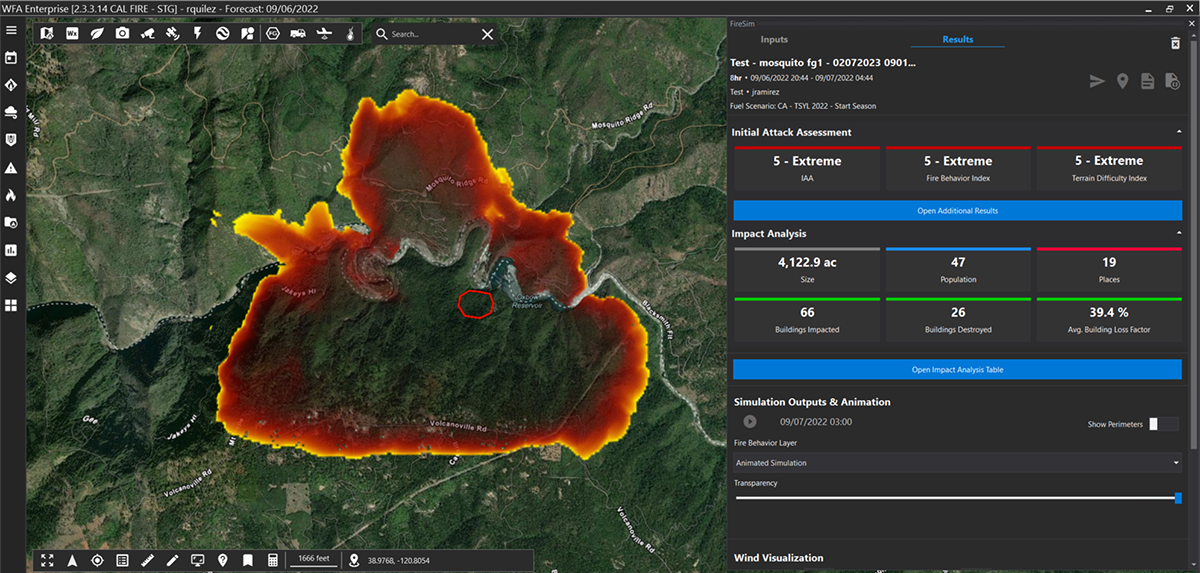
In addition to NASA satellite data, Technosylva’s FireSim uses topography, weather, and other data to generate computer models for fire spread over five days to help communities evacuate safely. Credit: Technosylva Inc.
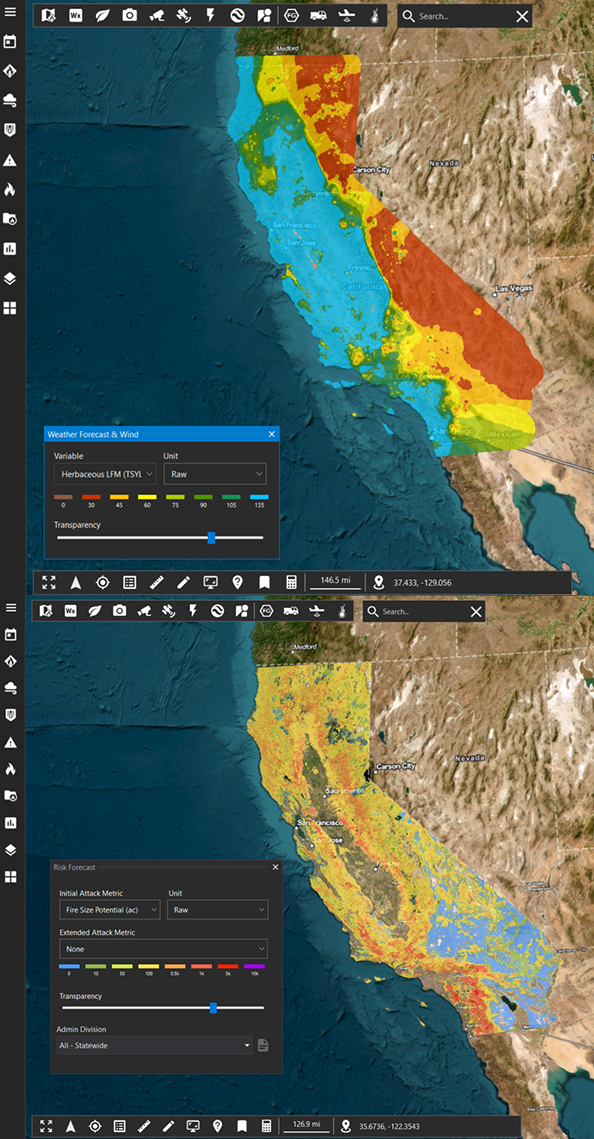
A recent discovery that soil moisture can impact wildfire predictions dramatically improved the accuracy of Technosylva’s FireCast service. Here, with the addition of soil moisture data – wet areas in blues and greens, the driest areas shown in reds and oranges – significantly reduced (top) the area originally predicted to be at risk of a serious fire denoted in color (bottom), enabling the placement of resources where they were eventually needed. Credit: Technosylva Inc.

Satellite imagery helps Technosylva’s Wildfire Analyst identify areas previously burned by wildfire to eliminate those areas without fuel like leaves or grasses (black circles) and pinpoint areas different types of available fuel (colored circles). Credit: Technosylva Inc.
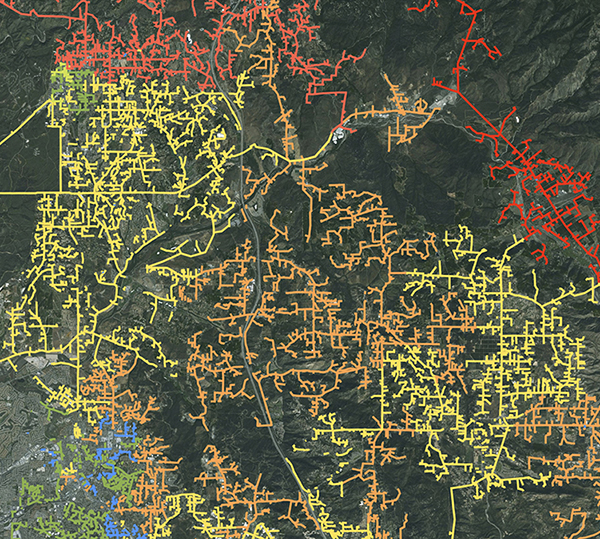
Utility companies are using Technosylva’s services to prepare for wildfires by identifying vegetation that needs to be removed and monitoring energy infrastructure during a fire. A map like this one reveals where power should be cut for safety (in red) and the areas that could be next (orange). Credit: Technosylva Inc.
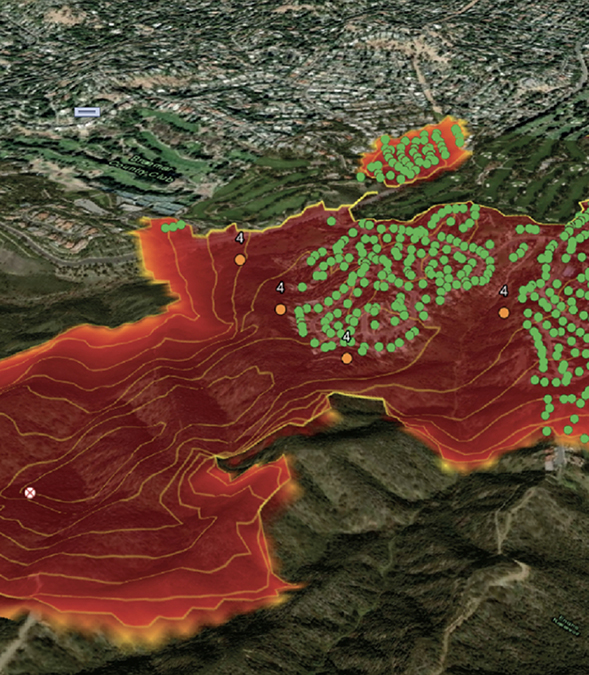
Knowing where a fire is and what infrastructure is in its path is essential for extinguishing the blaze. Technosylva’s fiResponse uses satellite imagery and more to show which homes, businesses, roads, and more (colored dots) are within the environment of a wildfire. Credit: Technosylva Inc.
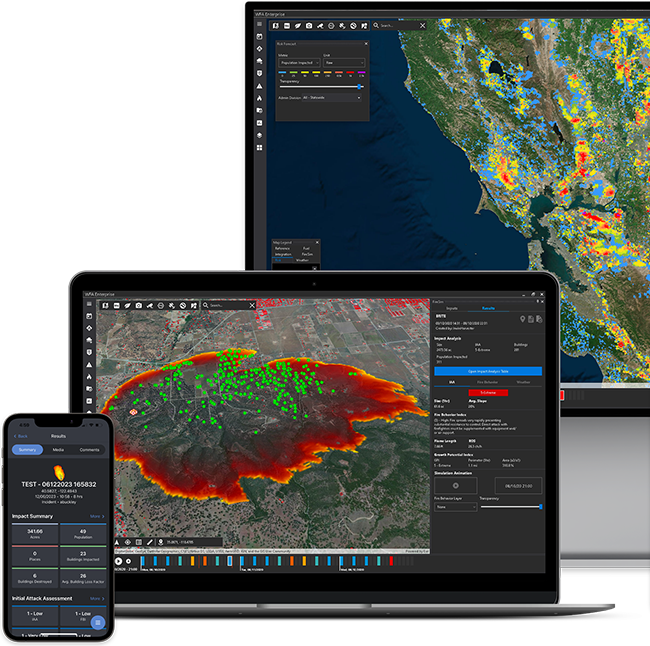
The web-based wildfire prediction, monitoring, and resource management service provided by Technosylva employs NASA data to help businesses, municipalities, and local communities deal with wildfires. The company manages over 20,000 incidents annually worldwide. Credit: Technosylva Inc.

In 2022, nearly 100 large wildland fires burned in the U.S. West. Almost two dozen of those burned Washington and Oregon alone, filling the air with smoke. Plumes from the fires often could easily be seen from space. Credit: NASA













